Where’s the Investing “Big Money” Headed Now?
Stock-Markets / Financial Markets 2010 Feb 22, 2010 - 06:40 AM GMTBy: Money_Morning
 Jon D. Markman writes: The remarkable week that just concluded actually began on February 12, which was two Fridays ago. Stocks plunged in the opening minutes of trading that morning as investors' faith in the global economic recovery was shaken. In China, policymakers again tightened monetary policy in a fight against rapid credit growth and fast rising asset prices. In Europe, which is plagued by concerns over the bailout of deeply indebted Greece, a report showed economic growth slowing dramatically.
Jon D. Markman writes: The remarkable week that just concluded actually began on February 12, which was two Fridays ago. Stocks plunged in the opening minutes of trading that morning as investors' faith in the global economic recovery was shaken. In China, policymakers again tightened monetary policy in a fight against rapid credit growth and fast rising asset prices. In Europe, which is plagued by concerns over the bailout of deeply indebted Greece, a report showed economic growth slowing dramatically.
For a few minutes, it looked like all of the prior week's advance would be lost and stocks were preparing to plunge into oblivion. But then, encouraged by a positive retail sales report, buyers swamped the tape -- focusing their attention on smaller, riskier companies, particularly in the technology sector. And off we went for the next six sessions.
It was an impressive show of strength under pressure by the bulls that brought all indexes back above support, crushing bears in the process.
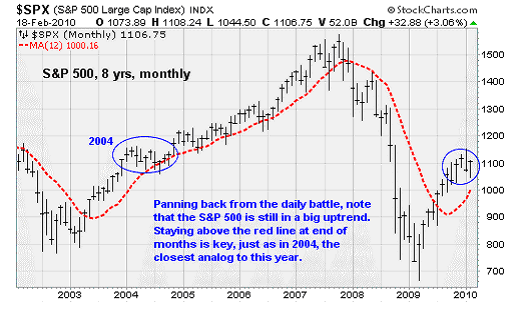
Some important variations among groups of stocks emerged, so if we choose the right places to put our money we can profit even if the overall trend is still sideways and down.
Before getting to those specific ideas, let me tell you what the big money is thinking, according to my contacts on the prop desks of major U.S. brokerages.
First, despite the uneven market at the start of this year, it is important to keep one thing clearly in mind: Group 20 central banks and governments still uniformly believe that their monetary and fiscal policy should be oriented toward boosting growth, not curbing inflation.
There is even a view that inflation is needed, and that this is not a good time to start cutting back on stimulus or to start raising interest rates. This is bullish for stocks, and it provides a bid under markets even when they're hit by rogue waves like the recent European sovereign debt crisis.
Second, this year is shaping up much like 2004. That year saw a 100-point range in the Standard & Poor's 500 Index between 1,150 and 1,050 for the first nine months of the year. The trading phenomenon known as "trend extension" was lacking then, much to the dismay of participants who were looking for strong trends and breakouts like the prior three years. We're seeing that again this year, no doubt. So the analog with 2004 is tracking quite closely -- almost uncannily so, given that the 1,050-1,150 range is virtually identical.
Third, so far this year only currency markets in the United States, United Kingdom and Europe have exhibited trend extension outside of ranges seen in the last quarter of 2009. All other markets -- equities, commodities, bond and emerging markets -- have either been characterized by erratic range-trading or mean-reversion back to Q4 2009 ranges.
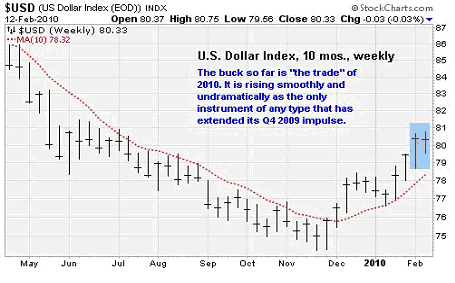
If you take a step back and think about it a moment, the snap version of what's happening now goes like this: 2008 was the year of the short-sellers. 2009 was the year of the longs. And 2010 will be the year of neither, which will whipsaw and frustrate both. A firm uptrend in the U.S. dollar as a safe haven from the euro mess so far is the only thing that 2010 so far has been good for.
Fourth, although companies have generated a lot of cash by selling bonds over the past year, and banks are enjoying the riches of a steep yield curve, neither are doing much with their money. They aren't hiring more people and they aren't expanding. Companies appear to be hoarding cash at a remarkable rate, almost to the extent that they can become their own bankers. This is an extraordinary development, and is probably the reason that stimulus funds have not trickled down to employment to the extent that most of us expected.
So now what?
Well, since stocks hit their recent closing low two weeks ago, there has been a noticeable performance differential between the small caps in the Russell 2000 Index and the mega caps in the Dow Jones Industrial Average and S&P 500 Index. It's only been half a month, but that is how leadership out of a low gets started -- so it bears watching carefully.
Such behavior may reflect a rise in investors risk appetites and suggests a rebound rally could be about to get started. Small caps and large caps have traded leadership roles repeatedly in the past year, but all of the major, long-lasting advances -- out of lows in March and July 2009 -- featured small fry in the vanguard. This challenges our view that high-quality stocks will be the most wanted in the next phase.
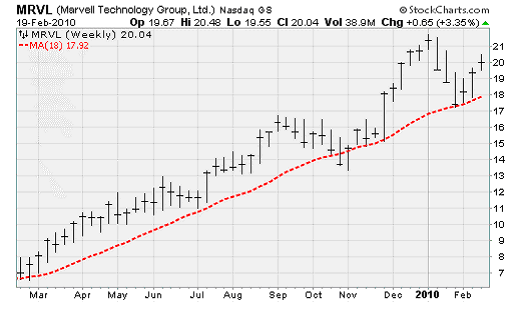
We're seeing similar leadership from technology stocks; specifically, by semiconductor-complex firms like new superstar Marvell Technology Group Ltd. (Nasdaq: MRVL), above, and Broadcom (Nasdaq: BRCM). Overall, the SPDR Semiconductor (NYSE: XSD) exchange-traded fund is up 10% in February -- more than triple the advance of the broad market.
Looking back, outperformance by chip stocks has ignited most important market moves over the last 18 months. The semis started outperforming in December 2008 -- presaging broad market strength four months ahead of the March low. They turned higher last May ahead of the big rally in July. They started moving in late November, when investors were distracted by the sovereign debt issues in Dubai, ahead of the mid-December stock rally. They fell hard in January, as a group, but since the beginning of this month, semiconductors have been on the move again.
The problem -- you knew there had to be a catch, right? -- is that semiconductors may be leading some stocks out of the ditch they've recently slipped into, but that doesn't mean all of them are getting back on the road as cleanly as Marvell. Industry goliath Intel Corp. (Nasdaq: INTC) still sees its shares fetching the same price they fetched in September. Many chips giants like Linear Technology Corp. (Nasdaq: LLTC) and Texas Instruments Inc. (Nasdaq: TXN) are only stirring after slipping back to August prices. This is what we mean by a choppy, sideways market -- only for these stocks the phase started early.
To be sure these can all find footing eventually, but here's the problem: Bull cycles need high-energy, high-impact leaders to rally the troops. And although the chips are trying their hearts out, they are not yet accomplishing that goal. Neither are other former tech leaders like Apple Inc. (Nasdaq: AAPL) or Google Inc. (Nasdaq: GOOG), or traditional leaders among the financial services companies like Goldman Sachs Group Inc. (NYSE: GS) or JPMorgan Chase & Co. (NYSE: JPM), which remain in downtrends.
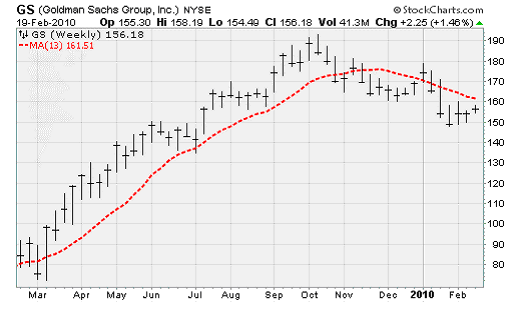
Goldman, in fact, has been a disaster despite all the largesse it's received from the government, as you can see in the chart above. Since peaking in October, it's been in a distinct downtrend with only two weeks' respite in four months. Investors believe that new regulations proposed by the government will fall harshly on Goldman, sapping its growth potential and driving away talent.
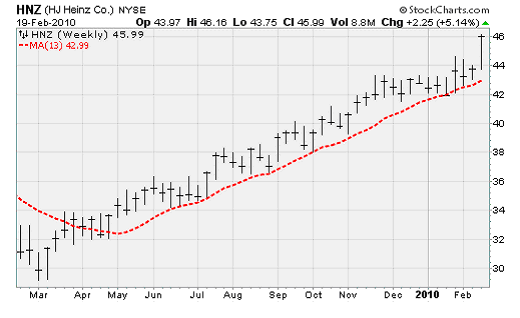
About the only real leaders I can find right now are food makers like H.J. Heinz Co. (NYSE: HNZ), ConAgra Foods Inc. (NYSE CAG) and Tyson Foods Inc. (NYSE: TSN), and regional banks like Fifth Third Bancorp (Nasdaq: FITB) and New York Community Bancorp Inc. (NYSE: NYB). These are not bad companies, they are cheap enough to merit attention, and they may end up being among the few to survive the flat spot we expect to see over the next nine months, but they won't command enough attention to truly lead a parade.
Leadership by food companies, in fact, is usually considered to be a negative, as it shows that institutional investors are plowing into "defensive" value stocks rather than fast growers.
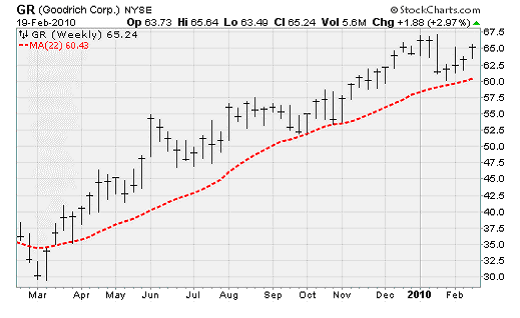
One other group showing some potential is companies that provide parts for the aircraft cycle that appears to be underway; not just The Boeing Co. (NYSE: BA), but also Goodrich Corp. (NYSE: GR), BE Aerospace (Nasdaq: BEAV) and Precision Castparts Corp. (NYSE: PCP) - and to a lesser extent avionics maker Rockwell Collins Inc. (NYSE: COL).
If shares of chip makers and these industrial manufacturers start to work in synch in the coming weeks due to improved optimism over second-quarter earnings, then these will be the place to put our money in anticipation of a retracement back toward the January highs.
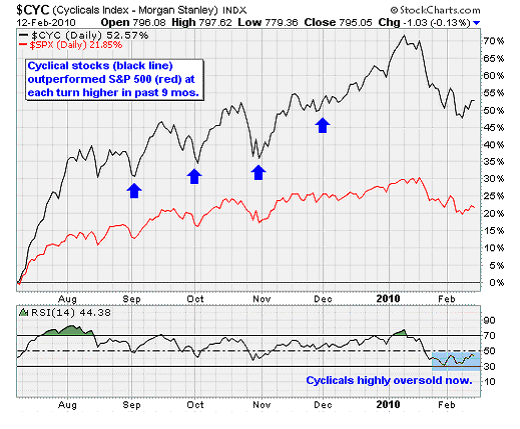
To see how this has worked at turning points in the last nine months, see the chart above, which compares the Morgan Stanley Cyclical Index ($CYC) to the S&P 500. The Cyclical Index is designed to measure the performance of economic sensitive industries in the United States, including autos, metals, machinery, chemicals, semiconductors and transportation.
You can see in the top clip of the chart how the August, September, October, November and December rallies were all much more acute for the cyclicals than for the broad market -- with much steeper angles of attack from the lows. In the bottom clip, you can see that CYC is trying its hardest to recover from the most oversold condition seen since the March low.
This suggests that at the very least, shares of cyclical companies like chips and industrials should enjoy another period of outperformance if bulls can muster their troops in the coming week or two.
Indeed, what we are really seeing is that big banks and energy companies, which exert huge influence on the major indexes due to their gigantic market capitalizations, are struggling at the same time that smaller companies in the indexes like Heinz and Goodrich are sort of paddling along. If you can isolate the successful companies in stronger sectors from the weaker mega-caps that rule the indexes you can probably outperform this year. That's easier to say than to do.
There are more reasons to be constructive on cyclical stocks. Jonathan Golub, an equity strategist at UBS AG (NYSE: UBS), reminded clients in a research note this week that while investors have been preoccupied with events in Europe and China, corporate America reported outstanding results in the fourth quarter. Finally, he said, companies are starting to see some top-line revenue growth to complement the earnings growth seen over the past few quarters due to deep cost-cutting initiatives.
The real story is that we are seeing a separation of performance between cyclical and non-cyclical corporations -- which is exactly what we would expect coming out of a recession. Removing the financials (since they are in unique circumstances at the moment), cyclical stocks have reported 25% year-over-year earnings growth according to Golub. Compare this to the relatively flat earnings growth by more defensive companies, such as health care, utilities and soap makers.
Technology and semiconductor stocks have reported especially strong earnings. In Golub's words, tech stocks have been "knocking the cover off the ball, posting top-line and bottom-line growth of 11% and 62%." See below for new exposure to the sector to try to take advantage of combination of healthy profitability and the unhealthy investor skepticism.
The Week in Review
Monday: Markets closed for Presidents' Day holiday.Tuesday: The New York Federal Reserve's Empire State Manufacturing Survey surged to 24.9 for February versus the consensus estimate of 18 and the prior period reading of 15.9. This is a very positive sign that manufacturing activity is strengthening in New York State. New orders and shipments continue to increase as inventories start to get restocked.
Wednesday: Industrial production increased 0.9% in January following a 0.7% jump in December thanks to manufacturing activity. Auto production was a big contributor to the gain, with motor vehicles and parts activity jumping 4.9% after a 0.3% decline in December.
Thursday: Initial weekly jobless claims continue to dance around the mid-400k region. The Producer Price Index made a surprise jump to the upside in January on a 5.1% surge in energy prices with gasoline up 11.5%.
Friday: The Consumer Price Index was also affected by higher energy costs, but a drop in shelter costs as rents fall kept a lid on overall inflation. A drop in hotel prices also contributed. Investors reacted favorably to the report since it means the Fed can continue to keep interest rates low on the lack of an inflation threat.
The Week Ahead
Monday: Federal Reserve chairman Ben Bernanke will speak before the House of Representatives on whether additional stimulus is needed to fuel job growth.Tuesday: The latest home price numbers from the Case-Shiller Index. Also, we will get a read on consumer confidence.
Wednesday: New home sales will be reported.
Thursday: Ben Bernanke speaks to Congress again, this time visiting the Senate.
Friday: A big day. The government releases its second estimate of fourth-quarter GDP growth. Also, look for existing home sales, consumer sentiment, and the Chicago Business Barometer to be reported.
[Editor's Note: As this analysis demonstrates, Money Morning Contributing Writer Jon Markman has a unique view of both the world economy and the global financial markets. With uncertainty the watchword and volatility the norm in today's markets, low-risk/high-profit investments will be tougher than ever to find.
It will take a seasoned guide to uncover those opportunities.
Markman is that guide.
Source :http://moneymorning.com/2010/02/22/big-money-investing/
Money Morning/The Money Map Report
©2010 Monument Street Publishing. All Rights Reserved. Protected by copyright laws of the United States and international treaties. Any reproduction, copying, or redistribution (electronic or otherwise, including on the world wide web), of content from this website, in whole or in part, is strictly prohibited without the express written permission of Monument Street Publishing. 105 West Monument Street, Baltimore MD 21201, Email: customerservice@moneymorning.com
Disclaimer: Nothing published by Money Morning should be considered personalized investment advice. Although our employees may answer your general customer service questions, they are not licensed under securities laws to address your particular investment situation. No communication by our employees to you should be deemed as personalized investment advice. We expressly forbid our writers from having a financial interest in any security recommended to our readers. All of our employees and agents must wait 24 hours after on-line publication, or 72 hours after the mailing of printed-only publication prior to following an initial recommendation. Any investments recommended by Money Morning should be made only after consulting with your investment advisor and only after reviewing the prospectus or financial statements of the company.
Money Morning Archive |
© 2005-2022 http://www.MarketOracle.co.uk - The Market Oracle is a FREE Daily Financial Markets Analysis & Forecasting online publication.



